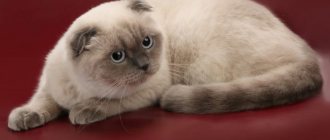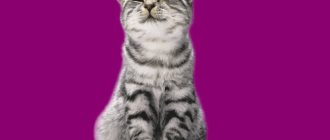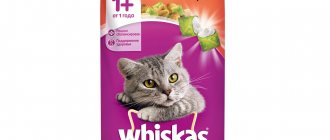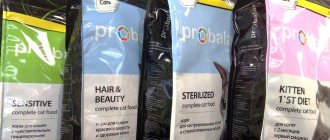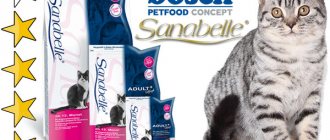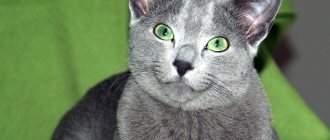The cats and kittens in the cat food commercials are whiskey colored. However, this is a conventional name for coat color. In order for the on-screen image of cats to become real, it is useful for the future owner to find out what kind of breed it is on the packaging of bags of food, and what the reference specimen looks like. And also understand what kind of health your pet has, the features of caring for it and feeding it.
The famous naturalist Harrison Way, the founder of the breed standards system, organized the world's first cat exhibition in 1871, and already in 1889 the white British cat was recognized as a purebred.
What breed of cat is in Whiskas advertising?
There is no need to beat around the bush: in advertising for kittens, we are always shown the same breed with the same color.
The breed of cat from the Whiskas advertisement is called the British Shorthair with a silver tabby color.
How did cats with this coat color end up in the economy class food rollers? A successful marketing move: the bet was made on the recognition of black markings on a silver background and the association with the yard color of the beloved Murki. In general, this is not a rare color for British women, but the food does not pretend to be elitist.
However, a cat with a silver tabby color is noticed immediately. And in case of unforeseen circumstances, the cat star of the commercial can be easily replaced - the viewer will perceive the new fluffy, thinking that it is the same kitten. Who thinks of counting the stripes and looking closely at their position in a short video?
Video: a tiny dose of cuteness from the creators of Whiskas
Torti (turtle)
It should be noted right away that you can only buy a turtle girl. In males, this color is not provided by genetics. But if you do come across a cat like this, then this is a big exception, which, however, does not increase its cost, but, on the contrary, reduces it.
Tortoiseshell color is considered to be fur on which spots of different colors (black, chocolate, blue, lilac) alternate with red or cream marks. For breeders, a particularly important indicator is the intensity of pigment expression and uniformity of location.
Where did the baby from the Whiskas food advertisement come from?
Different animals have been featured in commercials for a famous cat food at different times. Almost all of them are wards of the German nursery “Silver Treasure”. The first video featured a cat named Simba. The television career he began in 2003 was continued by his numerous descendants, in particular his sons Jesse and Chobi.
4 years after Simba's debut, Chiara, Bailey, Sally and Jamie took part in the filming. What is the name of the beloved kitten who was looking for his mother in an advertisement? This is a touching baby named Shamu.
The four-legged candidates for the main role in the Whiskas advertisement went through a rigorous selection process, because, in addition to filming in it, they had to become the official face of the brand. The following requirements were imposed on the tailed actors:
- a pretty appearance that evokes only positive emotions in the audience;
- traditional coloring, which in case of unforeseen circumstances would allow the four-legged actor to easily find an understudy;
- poise, obedience and friendliness;
- high ability to learn, which would make it easy to realize all the ideas of the director of the video and withstand several takes in a row with dignity;
- ability to pose;
- lack of fear of a large number of people, because usually there is a whole team on the set - from the firecracker to the director;
- well-fed without signs of excess weight and exhaustion;
- uniform shiny coat;
- clean eyes with a healthy shine;
- smart look.
What criteria were used to select the breed of kittens to participate in the Whiskas cat food advertisement? Representatives of this brand wanted to see a cat as its face, personifying an ideal pet in every sense: cheerful, healthy, active, balanced, well-groomed. According to their plan, the sight of such a cat should have touched even the most unemotional person. All these qualities were possessed by representatives of the cat breed, which received the unofficial name “Whiskas” after the advertisement was released.
Breeding
Breeding Scots should be left to breeders and nurseries. If pairs are crossed incorrectly, there is a high probability of getting sick offspring or animals whose defects will appear in the next generation.
Puberty
Maturity in animals occurs by the 8th month of life, however, a cat or male cat that has reached the age of 1.3 years is allowed to breed. Early pregnancy in animals leads to various birth complications, loss of litter, and reduced fertility.
Meeting with a partner
The cat meets her chosen partner on the second day of estrus, on the cat's territory. On the first day, the animals get to know each other, and skirmishes and conflicts are possible. The breeding partner must meet the WFC criteria to produce healthy offspring. To improve natural characteristics, animals of identical colors are mated; for example, you should not mix blue color with cinnamon, since in such cases the offspring are tortoiseshell in color, with heterochromia.
Mating of a fold-eared cat occurs only with Scottish Straight cats and, conversely, a fold-eared cat meets with a cat with erect ears. Sometimes it happens that fertilization does not occur after the first meeting of animals. It is advisable for the cat to stay with the cat for three days.
Pregnancy
Pregnancy in cats lasts nine weeks. The first signs appear in the second and third weeks. The nipples swell, change color, and the cat consumes a lot of food. During this period, it is necessary to exclude fish delicacies from the diet and add more fermented milk products, including natural yoghurts. In the fifth week, the cat’s belly is quite round, and the animal has gained significant weight. The entire period before the onset of labor, the cat behaves calmly and carefully.
Childbirth
Before the birth begins, the pet will begin to look for a place. It is quite possible that she will love an open closet or drawer. It is advisable to prepare a large cardboard box for the cat, lining it with a warm blanket or a thick layer of fabric. During childbirth, as a rule, outside help will only be needed to wipe the kittens from birth mucus and cleanse the sinuses, mouth and eyes. The cat will do the rest itself.
There are from 4 to 6 kittens in a litter. During the first days of life, the mother actively cares for and feeds them. At this time, you should not touch the cat or try to pet the kittens; the animal will respond with aggression. When the cat gets stronger, you need to take it to a doctor for an examination, and if any problems are detected, immediately begin their treatment.
Aftercare
As soon as the kittens reach one and a half months of age, the babies should be registered in the club. The establishment records all the characteristics of the kittens: gender, body size, color, and so on. Then you need to get a veterinary passport for the kids and get all the necessary vaccinations.
It is advisable to sell animals when they are adults, around 4-5 months of age. During this period, they will learn how to behave correctly with a person, where their place is, a tray, and they will learn to eat natural food or dry food.
Colors featured in advertising
The color of the British, who were filmed earlier and are now participating in advertising for Whiskas food, is called silver tabby. This coat color was not chosen by chance. It gives the purrs a toy-like appearance, which is why viewers love it.
In addition, this color is very common among British breed cats. This means that in the event of force majeure, the furry actors can be replaced, and the audience is unlikely to notice anything.
This is interesting! Nowadays, British silver tabby cats are often called “whiskey cats” or “whiskas cats”.
Not everyone knows, but the silver tabby coat color of the cats from the Whiskas advertisement comes in several variations:
- tiger (mackerel).
Kittens of this color have clearly visible stripes on their fur that resemble the skin of a tiger. This is exactly how the painted animal actors were most loved by the audience;
- marble.
This color is considered the rarest among silver tabbies. Cats with this color also have stripes on their coats, but they form patterns, and in the shoulder area the pattern resembles a butterfly. Animals with a similar color also participated in advertising for Whiskas food;
- spotted.
These cats have many black spots on their fur, which make them smaller copies of leopards.
It is important! Cats of any variety of silver tabby color have yellow or green eyes and an “M” mark on their forehead.
By what principle are kittens and cats selected for advertising?
All British shorthair candidates for a role in Whiskas food advertising undergo a very strict selection process. The following requirements apply to them:
- pretty appearance;
- silver tabby color;
- calm and friendly disposition;
- ability to withstand several takes in a row;
- ability to pose;
- the ability to perform the stunts planned by the director of the video;
- the ability to not get lost on the set;
- healthy and well-fed appearance;
- soft and shiny wool;
- lively sparkle in the eyes.
This is interesting! Compliance with the last three points is mandatory not only for aesthetic reasons, but also as a marketing ploy. After all, all these signs indicate the cat’s good health, which means that the food she advertises must be healthy.
It is quite possible that the British cats who starred in the Whiskas commercials did not acquire their beautiful appearance thanks to this food. All of them receive competent care, regular veterinary examinations and nutrition with super-premium food.
We recommend reading: Border Terrier: everything about the dog, photo, description of the breed, character, price
British cat character
These are real aristocrats. They walk slowly, do not make noise, can lie in one place for a very long time, they are unhurried and very clean, unpretentious in care.
It is almost impossible to find an adult British cat running around the house at the speed of light or riding on the curtains. All these cat pranks take place in their childhood. Their English upbringing does not allow them to jump on cabinets, peel off wallpaper and sharpen their claws on their owner’s favorite sofa. Due to their short fur, they practically do not shed.
They don't need to be educated. Even as a kitten, learning from their mother cat, the British will go to the toilet and sharpen their claws only in the place designated for this. If the cat wants to eat, he will come to his plate and sit there quietly until he is fed, without making unnecessary sounds. In general, they meow very rarely, only in cases of extreme necessity, for example, when they have to wait too long for their favorite treat.
The Briton is an ideal pet with virtually no flaws.
- calm friendly character
- cozy softness of fur,
- cutest appearance,
- many varieties of colors,
- ease of care.
Breed Features
Distinctive features of British Shorthair cats:
- Large size (adult cats reach a weight of 10 kg);
- Long, graceful body;
- The head is large, massive;
- The ears are round;
- Huge round eyes of bright amber, orange color;
- Short hair with a very dense undercoat, thanks to which these animals look like a plush toy.
At a young age, the British are active, inquisitive, and playful. They do not like to be held, they wriggle out, but do not scratch or bite.
Adult cats are aristocratic, reserved, they will no longer run around like kittens, knocking down obstacles. With age they become more careful in their games. Rarely raises his voice and does not become annoying with his presence. He will not beg for food because he is proud and will quietly wait for the treat.
There are also no problems with the toilet; once you have shown its location, you will no longer have to return to this issue. It’s the same with a scratching post - we highly recommend purchasing it, then show it to the cat, and he will only sharpen his claws there.
The British like to watch what is happening around them; they climb onto shelves and cabinets and watch those around them for a long time.
The British are not afraid of loneliness; they can remain alone for a long time. But they feel the arrival of the owner, meeting him at the threshold. They accept affection and attention to themselves, but only if they are in the mood, otherwise they will simply run away from you. They will prefer to respond only to their first names; the generally accepted “kiss-kiss” does not suit them.
How much should a real Brit weigh?
There is an old myth about the gigantic weight of British cats, which some dishonest breeders diligently maintain among ignorant people, spreading stories about cats weighing 15 kg. The massive skull with well-developed cheeks, the powerful squat bones of the British cat are the living embodiment of the fabulous Cat-Kotofeich and, of course, can be somewhat misleading, but you need to be able to analyze information. A 3-year-old child of average constitution weighs 15 kg (with a height of 1 meter)! So, in this case, what density should a cat’s body have for it to weigh the same?! Yes, he must have bones made of cast iron. :)) Even a very large and fat cat will weigh less than a small child. In fact, the average weight of a British cat is 3-5 kg, British cats 5-7 kg. Sometimes you come across small cats weighing 2.5 kg and especially large, well-fed cats, “pulling” 9 kg. Moreover, these are middle-aged cats, because... the skeleton gains weight with age - the bones become heavier, the skull increases in size. A cat suffering from unsatisfied sexual needs or, conversely, actively mating is usually dry and lean (and most breeders are like that) and, in principle, cannot weigh much.
What is the real name of the British Whiskey color?
Some ignorant people think that such a color really exists. In fact, cats do not have this shade, just as there is no breed with this name. A commercial for cat food stars a British kitten with one of the most popular colors - a tabby brindle variety. It also has another name - black and silver mackerel. You can see in the photo what a British kitten looks like from a cat food advertisement.
Diseases
The main problem of the breed is the presence of blood groups A and B. If the blood groups of the male and female are incompatible, weak kittens are born after mating, since the cat produces antibodies to the other blood group. On the very first day, antibodies are transferred through breast milk and if the kittens have a different blood type, they die within three days. In America, British people are given a DNA test and a couple is matched with the same blood type. Unfortunately, such analysis is not done in our country.
This breed is also characterized by complications in the functioning of the heart; they are often diagnosed with hypertrophic cardiomyopathy. Therefore, to maintain health, it is very important to eat high-quality food, with additives that improve the functioning of the cardiovascular system, and timely visits to the veterinarian.
Tabby color varieties
This coat color has several varieties:
Spotted tabby kitten
- Tiger tabby, or mackerel. Cats of this color resemble tigers in appearance. Like their predatory relatives, their fur coat has characteristic stripes of a darker shade than the main background, which stretch from the back to the stomach. The value of the animal depends on the number of vertical stripes and their clarity.
- Spotted tabby, or spotted. Animals with this color have dark spots of the same size evenly distributed throughout the body. There is an intermittent dark stripe on the back.
- Marble tabby, reminiscent of the pattern on marble.
- Ticked tabby, also known as Abyssinian. Each fur of the owners of this color is painted in 2-3 colors.
Whiskas cats, regardless of the pattern on their body, should have:
- the letter "M" on the forehead;
- a “necklace” on the chest, which can be either closed or open;
- stripes on paws;
- tail rings;
- 1–2 rows of markings on the belly;
- contrasting pattern on the back;
- a light spot on the outside of both ears;
- eyeliner and nose in the color of the main background of the body.
Solid (solid, plain)
A solid color implies the absence of any slightest admixture of other shades. The surface of the fur is colored evenly on all parts of the body. The Scots once upon a time considered gray or blue to be the most common color. These are the favorites most often found among breeders. But today seals with other colors are also gaining more and more popularity: white, chocolate, black, brown, cream, red and fawn (which literally means the color of a young deer). Sometimes it happens that nature interferes with the uniform color of the fur and leaves a mark of a different color there. Such cats noticeably lose value because they are considered a breed defect.
Other cat breeds - stars of the blue screen
The British from the Whiskas food advertisement are not the only representatives of the cat tribe who participated in similar commercials.
Here are the most famous characters from advertising, and not all of them are purebred:
- Persian chinchilla, which advertises Gourmet food.
These cats are distinguished by an upturned nose, expressive blue or emerald eyes, lush snow-white fur with a light silver coating and a very fluffy tail;
- Bengal cat from the video about the “Perfect Fit Active” food.
Representatives of this breed are very flexible. Their body is muscular and elongated. The unusual spotted or marbled pattern on the short, shiny and silky coat gives purrs a great resemblance to leopards;
- red “noble” cat from an advertisement for “Friskies” food.
For this video, a purebred short-haired pet was chosen with one of the most common colors - red with stripes;
- Maine Coon, which represents Purina One food.
It’s hard not to remember cats of this breed. They are distinguished by their very large size (the height at the withers can reach 41 cm, and the length including the tail - 135 cm), lush hair on the neck, tassels on the tips of the ears, a massive chin and a fluffy tail.
At first glance, cats of this breed look very menacing. In fact, they are very sociable, affectionate, playful and patient;
- gray with “nobleman” stripes from the Kitekat food advertisement.
We recommend reading: Types of Shepherd Dogs
A cat named Boris initially lived in a shelter, but fate brought him together with Yuri Kuklachev. Now Fluffy serves in the Famous Clown's Cat Theater, where he is considered one of the best actors. This animal is very smart, has an excellent memory and is well trained. He even knows how to ride a bike and skateboard;
- Russian blue cat from the video about Sheba food.
Representatives of this breed are very graceful and elegant. They are distinguished by velvety fur of a bluish-ash color that slightly lags behind the body, large almond-shaped green eyes and a long, thin tail.
When looking at cats from advertisements for Whiskas and other economy-class foods, one gets the impression that they owe their blooming appearance to the advertised product.
But you shouldn’t fall for such tricks of marketers. Only a careful study of the composition of the food and consultation with a doctor will keep your cat healthy and prolong its life.
Who is he - a funny plush kitten
The breed is called British Shorthair. There are several standard colors. The kitten from the Whiskas advertisement is a black, silver tabby. Characterized by the presence of dark patterns on a light background. Eyes green or yellow. There is a mark on the forehead in the form of the letter M. Tabby has several variations.
- Mackerel or tiger. There are thin tiger stripes on a light silver background.
- Spotted. Characterized by the presence of intermittent stripes and spots of different shapes and sizes.
- Marble. With spiral wide stripes.
Those who watch Whiskas advertising carefully have probably noticed that all the kittens are of different colors. But the one that stands out the most is the handsome mackerel. The kittens grew up in a British nursery. They have been appearing in commercials since 2003. Interestingly, cats of different breeds took part in the shooting: Burmese, Bengal. But for some reason the British kitten won the hearts of the audience.
How much does a cat “as advertised” cost and where can I buy it?
This is a fairly common breed, so there will be no problems with purchasing the same kitten as in the advertisement of the famous cat food. You can buy an animal at a bird market, at a pet store, through an advertisement, or at a nursery.
When purchasing a cat from your own hands, there is a high risk of getting a mongrel pet instead of a purebred one, and one that is not very healthy. To prevent this from happening, it is better to buy British dogs only in official nurseries.
When choosing, it is recommended:
- Read reviews about the nursery.
- Ask nursery workers to demonstrate documents for carrying out activities.
- Watch the animal you like for some time. Healthy babies are active, mobile, cheerful and responsive to sounds.
- Assess the living conditions of the animals. The nursery should be dry, light and clean.
- Ask to see the parents of the baby you like, if possible. The appearance and behavior of the baby's closest ancestors will say a lot about their heir.
- Assess the condition of the fur, eyes, ears and tail of the cattery inhabitant you like. If he is absolutely healthy, he has a shiny coat without bald spots, clean eyes and ears, an even tail without kinks. The baby should be moderately well-fed. An animal that is too thin probably has some health problems.
This is not the most expensive breed, so almost anyone can become the owner of such a cat. The price of British dogs consists of many factors: the popularity of the nursery, the title of the parents, compliance with standards, region, color. If you do not plan to breed British dogs or participate in exhibitions, you can purchase an animal without the makings of a future champion or qualities attractive for breeding. Such a purchase will cost several tens of thousands of rubles. Show-class babies cost 35–50 thousand rubles.
About the fat tail (belly, fat fold on the abdomen)
Inexperienced British owners often have questions: “The cat has grown up and its belly has sagged. Isn't this dangerous for health? Will the ratings at exhibitions be lowered for this?” Unfortunately, veterinarians sometimes not only do not help with competent advice, but often aggravate the fears of the owners, declaring that this is the beginning of obesity and the animal needs to be urgently put on a special diet, or, even worse, they declare that it is an inguinal hernia and it needs to be operated on! Monstrous dense ignorance of cat physiology. So, the fatty tail has nothing to do with the general condition of the animal and of course it is not a hernia, just fat deposition. In breeding cats, this fat is lost during the period of feeding kittens and increases again in the intervals between litters. In other animals - breeding cats and castrati - it simply constantly exists, neither increasing nor decreasing. Putting an animal on a diet in an attempt to rid it of this “beauty” is completely ineffective, it’s like trying to rid a cow of its udder with a diet! All you will achieve by cutting down on food intake is to get an eternally hungry, skinny Briton whose bag will stand out even more. Meanwhile, a Briton should look like an appetizing plump thing, and such a tummy does not spoil him at all. And competent judges at exhibitions are well aware of this feature of many British people and do not consider it a flaw in the exterior. By the way, the fat tail is found not only among British women; it’s just that many breed lines that formed the basis of the British breed have a feature in the form of a fatty pouch on the stomach. But there are also breed lines that lack this “decoration”.
| British cat | |
| Canadian Sphynx cat | Bengal cat |
| domestic cat | Domestic cat |
Whiskas cat food review
Whiskas dry and wet food is produced in Russia. The official website is, it contains basic information about the ingredients, as well as a lot of advertising text about how healthy this food is. But let's take a closer look at its composition and benefits.
This food belongs to the economy class. In addition to Whiskas, the Mars Corporation also produces such foods as Perfect Fit, Sheba, KiteKat, Royal Canin, Chappi, Pedigree, Cesar.
Whiskas feed composition
Let's look at the composition of Whiskas food using the example of the option “for kittens, delicious pads with milk, turkey and carrots.” You can see the composition below, left-click on the image to enlarge it for easier reading:
On the left is a photo of the composition from the food packaging, and on the right is a screenshot from the official website.
The first ingredient, wheat flour, is mainly a source of carbohydrates, as is rice, which is located a little further down in the composition. The percentage of wheat flour is not indicated, and since it comes first, and the percentages of the other ingredients are also not indicated, a large portion of this flour may be contained.
In second place is flour of animal origin, it is clarified that it includes: poultry meal, turkey meal, meat and bone meal. Neither the exact percentage nor which parts of poultry and turkey this flour includes is specified. Further in the composition (through 1 position) there are “protein plant extracts”, the percentage of which is again not indicated.
Poultry meal is certainly not all meat, and neither is meat and bone meal. However, there are no ingredients very rich in plant protein, so most of the protein must come from animal sources.
Animal fat (which animals are not specified) and sunflower oil are sources of fatty acids. Brewer's yeast is a source of B-group vitamins. Vegetables (carrots for sure) are a source of fiber. The remaining three ingredients are beneficial additives.
Advantages and disadvantages
The benefits of the food include:
- very common, sold in most supermarkets;
- low price;
- eat dry food, pouches and pates, treats;
- good vitamin and mineral supplement;
- Widely distributed, even sold in regular supermarkets.
We recommend reading: Dune cat: character and appearance features, photo of a desert cat
Disadvantages of Whiskas food:
- the percentages of the main ingredients are not specified, so it is impossible to say exactly how many meat ingredients are in the food and how many are plant ingredients;
- contains dyes (therefore the granules are multi-colored), but the manufacturer’s website states that they are organic;
- preservatives/antioxidants used are not specified.
In general, this food certainly cannot be considered complete, but the body, especially a growing kitten, needs a lot of useful substances.
Whiskas cat food - reviews
This food has long been present on the shelves of Russian supermarkets and pet stores, and is also actively advertised on TV and beyond. Therefore, many people managed to try it and there are a lot of reviews about Whiskas on the Internet. Below we publish a few of the ones we found.
Reviews from veterinarians
Evgenia Valerievna, a doctor from the Zoovet clinic, writes in response to a question about Whiskas:
Good afternoon Whiskas is certainly not the best food for cats. It is believed that the high content of flavors in economy class food makes it so attractive to animals, so try to switch your cat to a higher quality food. Taking into account the history of urolithiasis, medicinal food is most likely also needed. To prescribe a suitable diet, I recommend taking a urine test.
Customer Reviews
Alya writes:
Hi all! Today I’m writing a review about food for our little brothers, for cats! I feed my cat natural food, but I always keep dry food in stock. Sometimes I’m not at home for a long time and in such cases you can add dry food for the whole day in advance so that the cat doesn’t go hungry.
I usually buy Purina One, but last time I bought Whiskas. The cat reacted unusually to it, ate it very appetizingly and then hovered around the bag asking for more. The food clearly contains strong flavoring and aroma additives.
Writes IRINA-NIK ():
Whiskas canned food is a product of MARS. The choice is mine and my cat!!! Yes, comparison with ROYAL CANIN®, Pro Plan (rating based on the cat’s appetite!!!!) Before our beloved cat, he is a simple house cat, we had our beloved Cornish Rex, who left after a long illness……. To the rainbow…………………………………..
So, I only ate ROYAL CANIN®, and not everyone was suitable for it..... Time passed and a new addition appeared in our family, for whom I also bought premium food, because... You won’t immediately understand what he likes, you have to select it. BUT. Neither ROYAL CANIN® nor Pro Plan took root in the diet; I ate without appetite and turned up my nose. And here.
In a conversation with my friend, I find out that he was at the factory where Whiskas is made, and so, all the ingredients there are natural, the only difference is that the percentage of protein in Whiskas is lower. The same goes for other indicators. By the way, Whiskas and ROYAL CANIN® are products of MARS. Only premium class and masses, that's all.
A user with the nickname NewSky writes:
Cat food "Whiskas" stew is very expensive in price, almost 20 rubles per bag. But its quality is noticeably better. Already, as soon as you take Whiskas food in your hands, you feel that the bag itself is pleasant to the touch, soft. It opens easily and is rarely not along the line, i.e., it does not tear askew, as happens with other feeds, for example, with Kitekat.
The smell is really strong and disgusting. In general, the smell of Whiskas canned food surprised me: it smells like dry food, with such a pungent, pungent odor. This is the first time I've seen this. More precisely, I smell it. However, the food itself looks fine, with solid pieces of meat, and the sauce does not spread from it. Sometimes even all the food comes out of the bag in one slab, like Felix.
The cat eats and purrs with joy, but there were no consequences after the “Whiskas” stew. Although it seemed to me that the cat is not very full of Whiskas, since after a bag she immediately asks for more, although I have not observed this with other foods.
And the composition is chemical-free. I take different flavors, but they all smell the same. As for the price. Thus, I recommend "Whiskas" stew for cats.
Sources
- https://101kote.ru/stati/koshka-iz-reklamy-viskas.html
- https://kot-pes.com/poroda-koshki-iz-reklamy-viskas/
- https://MurKoshka.ru/porody/okras-viskas.html
- https://litbro.ru/interesnoe/poroda-koshek-iz-reklamy-viskas
- https://porodakoshek.ru/porody/evropejskie/poroda-kote-nka-iz-reklamy-viskas.html
- https://petobzor.com/korm-dlya-koshek-whiskas-otzyvy-i-razbor-sostava/
[collapse]
This scary word is “inbreeding” or mating with close relatives
Inbreeding (from the English breeding - reproduction) is the crossing of closely related forms within the same population of organisms (animals or plants). Inbreeding is one of the most important components of breeding! The offspring in inbred lines are distinguished by homogeneity not only in appearance (which can be achieved by mating with a prepotent, i.e., persistently transmitting its traits, sire), but also in genotype, while inbreeding reveals both obvious (dominant) and hidden ( recessive) characteristics of a common ancestor. All negative reviews about inbreeding are dictated by nothing more than the fear of clearly getting well-known hidden defects of the manufacturer in the descendants and, accordingly, losing many potential brides. It can be very sad to see how a huge integral component of competent breeding work is discredited for personal petty selfish purposes. But it is precisely through the consistent, skillful use of inbreeding and selection that breeders achieve the consolidation of the necessary characteristics in the genotype of the breed line and the purification of it from undesirable ones! Unfortunately, inbreeding in the wrong hands is like a grenade in the hands of a monkey. It is necessary to firmly understand that the success of inbreeding is determined, first of all, by the quality of the genotype
ancestor. The animal being inbred must be in good health and in type as close as possible to the standard. It should also be taken into account that not every descendant of an outstanding sire is suitable for inbreeding, since the gene set of each kitten is strictly individual and more or less different from littermates in the number of genes inherited from its ancestors
Therefore, having decided to inbreed on a certain sire and having his grandchildren and great-grandchildren at your disposal, it is important not to make a mistake and choose for inbreeding those descendants who carry in the genotype the maximum set of genes of their outstanding ancestor. And since it is not possible to genetically analyze the DNA of all breeding animals, to carry out inbreeding it is necessary to select a descendant in the type of your great ancestor, the one most similar in appearance to him
This is the most reliable way to guess the desired genotype.
It is necessary to distinguish between close, moderate
and distant
inbreeding, which differs in the degree of closeness of relationship of the crossed producers. For this purpose, notations using Roman numerals are adopted. Close inbreeding is the mating of a parent with a direct descendant or between a brother and sister, which corresponds to I - II, II - I and II - II. Moderate inbreeding is the crossing of second cousins or the mating of a sire with an indirect descendant, for example, a grandfather and a great-granddaughter. Options for moderate inbreeding - III - III, IV - III, I - IV, etc. And finally, distant inbreeding is the crossing of animals that have a common ancestor in 4-5 generations and further, already outside the visible part of the pedigree, for example V - IV, V - VI, IV - VII, etc. Inbreeding on several ancestors possessing desirable breed characteristics is also possible.

